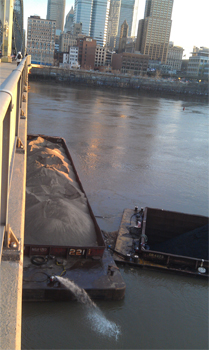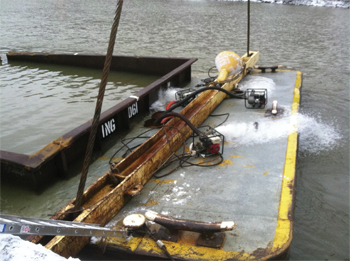Two barges broke free from a towboat after hitting a bridge support column on the Monongahela River near downtown Pittsburgh.
The 4,300-hp towboat Marge McFarlin was westbound toward the Ohio River pushing 12 loaded coal barges when at least one barge struck the Liberty Highway Bridge at about 0100 on Jan. 19.
 |
|
The gravel barge 221 is pinned underneath Pittsburgh's Smithfield Street Bridge and its rake is being pumped out, while a coal barge rests alongside. (Photo courtesy U.S. Coast Guard) |
One of the runaway barges was damaged and eventually sank. The other struck a barge moored in a fleeting area, and both became pinned against a bridge downriver until salvage crews removed them. The 10 remaining barges were removed without incident.
A preliminary investigation by the U.S. Coast Guard suggests strong winds may have been a factor in the accident.
"The preliminary report was that he got caught by a gust of wind and his barges got pretty much pushed in the direction of the bridge," said Lt. j.g. Alyssa McDonald, the assistant response chief at Marine Safety Unit Pittsburgh.
McDonald cautioned that an investigation into the incident was ongoing. Nobody was injured and there was no environmental damage, the Coast Guard said.
Winds were estimated at about 14 mph from the southeast on the morning of the accident. At the nearest measuring site, the Monongahela was nearly 10 feet higher than normal, McDonald said.
The 144-foot Marge McFarlin was operated by Ingram Barge Co., which is based in Nashville, Tenn. The company's internal investigation suggests high water may have contributed to the incident.
The vessel's pilot "misjudged the river's above-normal current and ran out of stern room, resulting in the starboard stern of the barge ING 5061 alliding with the left descending channel pier of the Liberty Avenue bridge," said Dan Mecklenborg, senior vice president and chief legal officer at Ingram Barge.
 |
|
Equipment from River Salvage pumps out voids from the sunken runaway barge ING 5061. The accident began when the tow struck a bridge column upriver. (Photo courtesy U.S. Coast Guard) |
Mecklenborg declined to comment on whether disciplinary action was taken against the pilot, who he said has more than 15 years experience operating towboats on inland rivers.
After the initial accident, the 195-foot barge ING 5061 drifted about a half-mile downriver and sank near the Fort Pitt Bridge. The other breakaway barge, the 195-foot OR 4875, hit the 195-foot gravel barge 221 that was moored in a nearby fleeting area, and both came to rest about one-third mile downriver against the Smithfield Street Bridge.
Two highway bridges and a bridge that carries Pittsburgh's light rail were closed for several hours Jan. 19 while crews from the Pennsylvania Department of Transportation (DOT) and the port authority inspected them. PennDOT's press officer, Jim Struzzi, said none of the state's bridges were damaged in the incident.
Ingram Barge hired River Salvage from Pittsburgh to perform the salvage, which began within eight hours of the incident. According to Mecklenborg, salvage crews first secured any barges that were in danger of sinking. This included the two pinned barges, which were pumped out while crews removed them from the bridge supports. Then, a floating crane was brought in to start removing coal from the sunken barge.
"On the following day, remaining product was removed from the sunken barge, and an A-frame crane was rigged to the bow end of the wreck and it was partially raised. On the second day following the incident, the A-frame crane was moved to the opposite end of the barge (and) the hull was fully raised, pumped out, secured and removed from the incident site," he said.
The two pinned barges were refloated and removed Jan. 19. The sunken barge was raised by Jan. 21.
The Port of Pittsburgh set up a safety zone along a two-tenths mile section of the Ohio River shortly after the accident. The full width of the Monongahela River from mile marker 0 to mile marker 1.2 was temporarily closed to traffic other than salvage crews. All told, 10 vessels requested passage through the safety zone, and all were accommodated, the Coast Guard said. The river reopened Jan. 21.
Ingram Barge said there were "financial damages involving Ingram's equipment, third party equipment and cargo," but declined to elaborate.
"Ingram has satisfied all of these items," Mecklenborg said.
